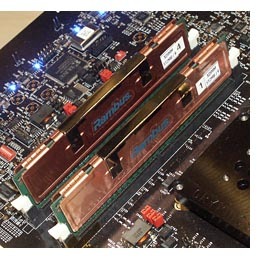XDR2 to quintuple memory data transfer speeds by 2007
Los Altos (CA) - "Parallelism" is the keyword underscoring several semiconductor architectures this decade. Now it's the turn of the memory: Rambus announced the availability of "micro-threading" for XDR2 memory, the company's next generation memory technology. Memory clock speeds will catapult to 8 GHz, up from a current maximum of 4.8 GHz of XDR1.
"The bandwidth requirements of game platforms and graphical applications have been growing exponentially," Steven Woo, Rambus' senior principal engineer at Rambus, told Tom's Hardware Guide. "About every five or six years, it goes up by a factor of 10. PlayStation 3, for example, will have a memory bandwidth capability of 50 GByte per second." If this trend continues, projected Woo, a theoretical 2010 model "PlayStation 4" could require ten times the memory bandwidth as next year's PlayStation 3. A statistical projection made in 2004 by NVIDIA's Vice President of Technical Marketing, Tony Tamasi - cited by Woo - anticipates that a top-of-the-line 3D game could conceivably require memory bandwidth of 3 TByte per second.
To begin addressing this staggering upward slope to which NVIDIA and others are pointing, Rambus unveiled XDR2, with a range of added and enhanced technologies, including the company's new simultaneous data throughput concept, micro-threading.

Another problem in modern memory technologies is the increasing Byte-size of data pieces that can be accessed. This loss of "granularity" actually results in performance degradation, especially with graphics cards that require rapid access to smaller and smaller triangles to achieve true high-definition rendering. Micro-threading addresses this problem, stated Woo, first by recognizing that DRAM technology divides banks of data elements into halves or quadrants, and next by developing a technique by which those quadrants can be addressed both independently and simultaneously. No bandwidth is lost, but access granularity is theoretically divided by four, at the expense of a "small" increase to the number of commands required to access data within the independent quadrants, according to a Rambus white paper.
The payoff may come in the form of capabilities for future graphics cards to establish very deep, very narrow look-ahead pipelines for very small triangles, which could lead to another huge performance boost for scene rendering. "Those pipelines are so incredibly deep," said Woo, "that you have lots of visibility way ahead of time as to where the triangles are, and where they're going to be accessed from."
Also included in the XDR2 technology package will be an enhancement to the FlexPhase timing system Rambus introduced in first-generation XDR. Typical motherboard routing involves the careful placement of traces that may take serpentine paths all over the board, just to ensure that they end up the same length, so that signals arrive between components at the same time. FlexPhase eliminates the need for serpentine routing, stated Woo, through the inclusion of offset logic for every wire on the controller. "We go through a calibration sequence that says, 'How far ahead of this other signal does this particular signal need to be launched, in order to guarantee they hit the DRAM at the same time?' [Our] procedure figures out how much delay you need to add to each wire." A converse procedure is applied, said Woo, for data transmitted from the DRAM back to the controller.
If licensing negotiations for XDR2 technology were to begin now, Rambus' announcement states, the technology could conceivably be shipping in products by 2007. The company's XDR technology is currently licensed by Toshiba, Elpida, IBM, and Samsung. Offering what could be construed as an olive branch to the computer industry, Rambus officials have told Tom's Hardware Guide that micro-threading alone could conceivably be licensed as a DRAM technology in and of itself, although no formal plans to do so have been announced. Rambus' attempt at restoring its reputation among both its clients and the general public, as quickly as XDR2's promised transfer speed acceleration, will be very interesting to watch.
Get Tom's Hardware's best news and in-depth reviews, straight to your inbox.